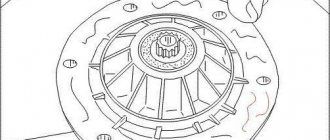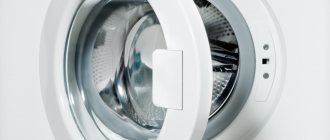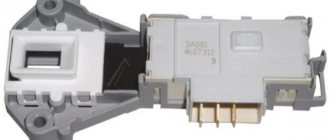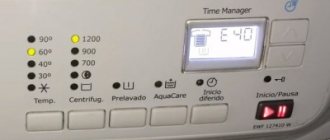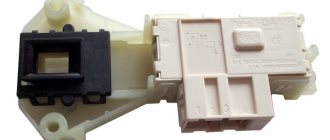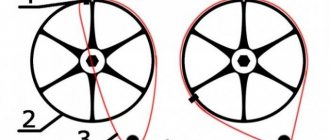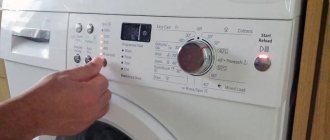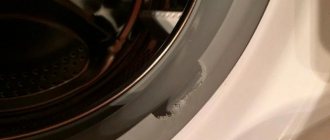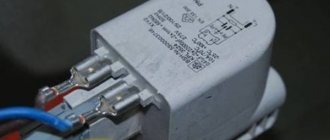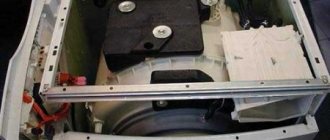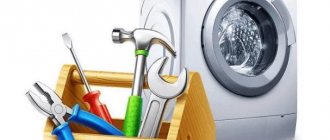Operating principle and types of locks
Today, two types of locks are commonly found:
- Electromagnetic.
- Bimetallic.
The first type is used less and less. Its main drawback is that the lock only works properly as long as there is electricity. If the light is turned off, the washing machine will not be unlocked.
The operating principle of a bimetallic lock is very simple: voltage is applied to the thermal element and heats it up. The hot thermocouple heats up the bimetallic plates; under the influence of heat, they expand and press on the lever. It goes off and blocks the door. At the end of the program, the voltage supply to the lock stops, the plates cool down, narrow and the latch returns to its original place. The washing machine hatch is unlocked.
The second type of locks has a number of advantages. Firstly, there is a delay in unlocking the hatch at the end of the program. This is necessary so that the washing machine completely drains the water and all its elements complete their work. Secondly, even if the power goes out, the lock will unlock, and the door can be opened and the laundry taken out. This type of UBL is used by many modern manufacturers of washing machines - LG, Samsung, Indesit, etc.
Simulating enabled UBL
To start the machine with a broken lock, you will have to “convince” the control module that the lock is in absolute working order. You can deceive the intelligence of an automatic machine if you close the UBL contacts in the locking position. To do this, you need to understand how the mechanism works.
The standard blocker has 3 contacts - N, L, C. The first two are supplied with voltage. Due to this, the thermal coil heats up, which heats up the bimetallic plate. The hot plate then closes pins L and C together.
Closing the two outer contacts is a signal to the “smart” module that the hatch door is tightly closed. After this, the “brain” activates the inlet valve and water begins to flow into the tank.
To turn on the machine with a broken lock, you need to close the two outer contacts of the UBL - L and C - with a jumper.
Having returned the “converted” blocker to its place, try starting the cycle. The machine may “think” for a few minutes, but in most cases the wash will start. There is no need to yank the door to see if it is securely closed. The locking device does not work, so opening the hatch will be very simple.
This trick will not work with the most modern machines. They have a protective algorithm, so closing the contacts with a jumper will only result in an error code being displayed on the display. Such technology is rare today, so you can try to “deceive” the electronic module.
Interesting:
- Ariston washing machine hatch won't close
- Disabling the washing machine UBL
- Kaiser washing machine errors
- How to remove the lock of an Indesit washing machine?
- Washing machine door closing sensor
- The lock on the Indesit washing machine does not work
Reader comments
- Share your opinion - leave a comment
Reasons for lock failure
There are several reasons why the door lock of a washing machine breaks.
- Firstly, this is the wear of bimetal plates as a result of prolonged use of the equipment. As a result of regular deformation, their functional properties are lost.
- Secondly, the reason may be a short circuit.
In some cases, the problem may not be with the UBL. If the washing machine has finished working, but the door does not open, the triacistor on the central board responsible for the operation of the lock may be faulty. In this case, voltage continues to flow to the locking device and as a result the door remains locked.
Why does the UBL fail?
You already understand how the UBL of a washing machine works and what are the advantages of using it. Why does the lock break? Here are the main causes of the malfunction:
- Long-term use causes wear of the bimetallic plates. As a result of constant deformation, the plates lose their functional qualities.
- Due to a short circuit, the device also fails.
As long as voltage is supplied to the device, it works. Therefore, if your washer has stopped, but the door has not unlocked, do not rush to blame the locking device. Most likely, the triac on the electronic board, which is responsible for the operation of the UBL, has broken down. The power is supplied continuously, so the door does not open.
Symptoms of a problem
The owner of a washing machine can determine if the lock is broken by the following signs:
- The equipment completed its work and turned off, but the hatch was still blocked. This indicates a malfunction of the UBL or central module.
- After selecting and turning on the mode, the door does not lock and the washing machine does not start executing the program.
- The washing machine displays a code or reports a UBL malfunction by flashing indicators in a certain sequence.
You can determine what the cause of the breakdown is using a multimeter.
We determine the breakdown without disassembling the machine
It is not necessary to disassemble the machine to verify that the UBL is faulty. Sometimes you can diagnose a breakdown of the blocker remotely - by the behavior of the washing machine itself. The main thing is to know the structure of the machine and the operating principle of its components. As a rule, a damaged electronic lock reveals itself with several “symptoms”.
- If the washer hatch remains locked for several hours after disconnecting the machine from the power supply, then the UBL is faulty.
- If, when starting the cycle, an error code is displayed on the display indicating problems with the UBL (for most Indesit models, the combination “F17” signals a faulty lock).
- If after selecting a program the machine does not lock the door. In this case, either the electronic lock or the control board is broken. The multimeter test described above will help determine the “culprit.”
! If there are problems with the UBL, the self-diagnosis system of Indesit machines displays the error code “F17”.
Thanks to UBL, the machine has double protection, which will prevent a person from opening the door when the tank is full. If the lock is “buggy” and cannot be removed or installed, then it is necessary to urgently diagnose and fix the problem.
Interesting:
- The door does not open after washing in a Bosch washing machine
- Washing machine door closing sensor
- How to check the lock of a washing machine
- LG washing machine hatch won't close
- Beko washing machine door won't close
- The lock on the Indesit washing machine does not work
Reader comments
- Share your opinion - leave a comment
Diagnostics and repair of the lock on your own
To check the serviceability of the lock, it will need to be removed. Necessary:
- Unplug the washing machine.
- Open the hatch, bend the cuff, pry up the clamp and remove it.
- Pull the cuff to the side to gain access to the lock.
- Unscrew the fasteners securing the device.
- Disconnect the wiring and pull out the UBL.
This method is suitable if the door opens. Otherwise, you need to open the base panel on the front of the washing machine and find the emergency cable for opening the hatch. It is usually yellow or red and is located near the filter. If the cable is missing, you need to unscrew the fasteners holding the top cover, remove it, and then put your hand between the body and the tank, find the lock latch by touch and unlock it. Now you can open the door and begin removing the UBL.
Now you can start checking the blocker using a multimeter. To determine where the neutral and common contacts are located, you will need a diagram of the lock. Hatch locking devices are produced by various companies that arrange the contacts in their own way. Without knowing the diagram, it is impossible to understand the contacts and diagnose the lock. You can find the diagram on the Internet.
At home, you can only check the thermoelement that heats the plates. To do this you need:
- Set up the multimeter to measure resistance.
- Find the neutral and phase contacts and install probes on them.
- If a three-digit number appears on the tester display, this indicates that the blocker is working.
- Now you need to move the probes to the neutral and common contacts.
- If one or zero appears on the screen, the device is broken.
If the blocker is working properly, you need to inspect it for mechanical damage or manufacturing defects.
To replace, you need to purchase a new lock. This can be done at the manufacturer's service center, in a specialized store, or via the Internet. To avoid mistakes when purchasing a part, you need to tell the seller the make and model of the washing machine.
Installing the hatch lock is performed in the following order:
- Connect the wiring to the UBL.
- Place the lock inside the washing machine and insert it into the seat.
- Screw in the fastener.
- Return the cuff to its original place and install the clamp.
If after replacing the UBL the problems continue, this indicates a malfunction of the system board. It is not recommended to repair it yourself, because it can only worsen the situation. To diagnose and repair the breakdown, you should contact a service center or call a professional.
Some washing machine owners are interested in whether it is possible to bypass the lock and start washing. Theoretically, there is such a possibility, but in this case, everyone who has access to the technology will be at risk of electric shock. Also, if you open the unlocked door during washing, there is a risk of being scalded by hot water. It is for these reasons that it is recommended to carry out repairs and replace a part that is inexpensive, rather than searching for a way to bypass the blocking.
What is the reason for the breakdown of the UBL
There are two main reasons why the hatch locking device may fail:
- mechanical wear of thermoelement plates;
- a sharp and strong surge in voltage - the plates lose their properties, even to the point of destruction; with a voltage drop, the internal winding can also burn out.
How to determine if the locking device is broken and what to do
A sign of a breakdown is that the machine door remains locked at the end of the washing cycle or, conversely, does not lock before the washing starts and the washing process does not start. On some machines, information about a breakdown appears on the display or LED indicators begin to blink and the washing process is blocked.
In this case, you should contact a service center or be sure to call a repairman to your home, he will conduct diagnostics and, if possible, immediately fix the problem. We are ready to repair washing machines Electrolux, Samsung, Ariston and many other brands. Call!
The second sign of a UBL breakdown is a situation when nothing happens when you press the “Start” button. This problem has two options:
- failure of the electronic module;
- Washing machine door lock is broken.
To accurately determine the cause of the failure, you need to call a specialist. If the technician confirms that the UBL is broken, then there is only one way out - buy a new device, since this component of the washing machine cannot be repaired. There is good news in this situation. You can order or buy UBL in our service center at a relatively low price. Low prices provide our center's clients with savings of time and money when searching for spare parts for a washing machine.
Operating principle and types of blocking
Before you check the lock in the washing machine, you need to understand how this device works. Often, in modern cars, manufacturers use two types of locks:
Electromagnetic. This blocker is used less and less. The disadvantage of using it is that it works as long as there is electricity. If it is turned off, you will not be able to open the hatch.
Bimetallic. The design and principle of operation of the lock on the hatch door is quite simple: electricity is supplied to a thermal element, which heats up due to this. At the same time, it heats the bimetal plates, causing them to bend, putting pressure on the lever. The latter is triggered and closes the door.
Such thermal locks with bimetallic plates are considered the most effective.
There is a delay when unlocking the door. For what? Until the water has completely drained and all parts of the machine have stopped moving, the door should not be opened for safety reasons.
Another advantage of thermal locks: they can be opened during a power outage.
